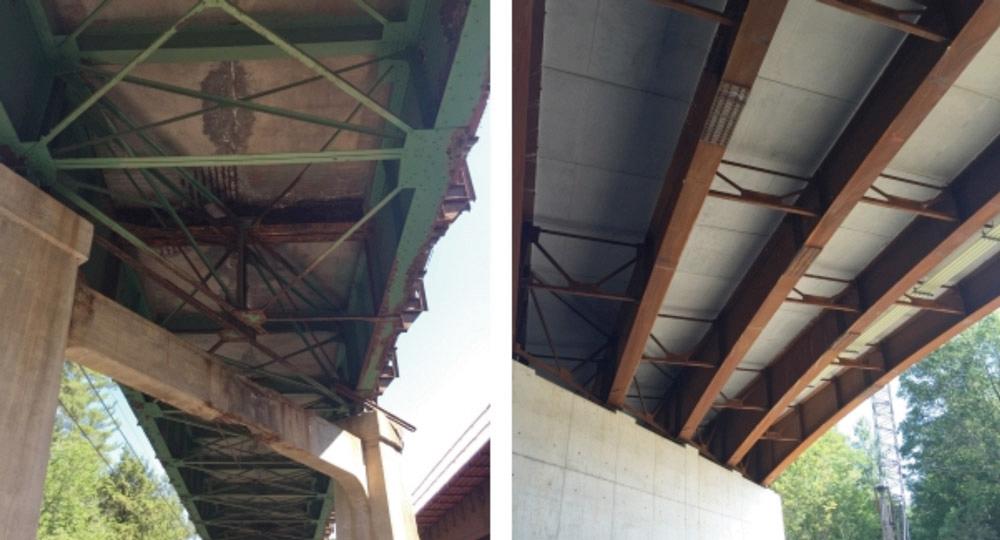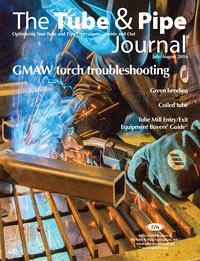- FMA
- The Fabricator
- FABTECH
- Canadian Metalworking
Categories
- Additive Manufacturing
- Aluminum Welding
- Arc Welding
- Assembly and Joining
- Automation and Robotics
- Bending and Forming
- Consumables
- Cutting and Weld Prep
- Electric Vehicles
- En Español
- Finishing
- Hydroforming
- Laser Cutting
- Laser Welding
- Machining
- Manufacturing Software
- Materials Handling
- Metals/Materials
- Oxyfuel Cutting
- Plasma Cutting
- Power Tools
- Punching and Other Holemaking
- Roll Forming
- Safety
- Sawing
- Shearing
- Shop Management
- Testing and Measuring
- Tube and Pipe Fabrication
- Tube and Pipe Production
- Waterjet Cutting
Industry Directory
Webcasts
Podcasts
FAB 40
Advertise
Subscribe
Account Login
Search
Building bridges for the 21st century and beyond
Fabricator, erector Casco Bay switches to plasma for fast, accurate cuts
- By Eric Lundin
- July 7, 2016
- Article
- Tube and Pipe Production

Girders and steel plate used in bridge construction represent fabrication on a huge scale. Casco Bay Steel Structures often fabricates components that exceed 100 feet long.
More than a half million bridges carry cars and trucks across rivers in the U.S. every day. The U.S. Department of Transportation estimates one in four of these bridges is structurally deficient or functionally obsolete. This is not surprising given that the majority of U.S. bridges are 50 to 60 years old, having been built during the 1950s and 1960s after President Eisenhower signed the Federal-Aid Highway Act.
In fact, two of the largest bridge failures in the past decade occurred on bridges built during that time. Minnesota’s I-35W Bridge, which opened to traffic in 1967, came down during the evening rush hour in 2007, sending dozens of vehicles into the Mississippi River. Even though the bridge on Interstate 35 was the second busiest span in all of Minnesota, and even though the bridge had been flagged as “structurally deficient” as early as 1990, construction of a new bridge was not scheduled until 2020.
Nearly six years later, a portion of another bridge on another major artery, I-5 in Washington, collapsed after an oversized truck carrying a load to Vancouver struck several overhead support beams. This span, crossing the Skagit River and built in 1955, had already been flagged as "functionally obsolete” because it didn’t have redundant load-bearing beams. Engineers recognized that the failure of just one critical part could cause the whole bridge to come down.
In spite of these disasters, the Federal Highway Administration insists U.S. bridges are safe. It says that the structurally deficient designation simply means a bridge has a structural defect requiring a load limit or traffic limit, and that bridges designated as functionally obsolete are carrying more and heavier traffic than originally intended.
Whether or not federal and state experts consider the bridges unsafe, they agree that the bridges are, at the very least, vulnerable. The good news is states are working to fix or replace many of these more vulnerable bridges. A $4 billion replacement of New York’s Tappan Zee Bridge is the largest bridge project underway in the U.S. now, but it’s certainly not the only one. Projects are underway in all 50 states, with the most urgent work taking place in northern states, where bridge construction progress is limited by winter weather.
Building Better Bridges
One fabricator involved in bridge-building projects is Casco Bay Steel Structures, South Portland, Maine. Each year more than 20,000 tons of steel pass through its doors. From two locations in Maine, more than 100 people work to cut and weld steel girders together. This steel will make its way into one of Casco Bay Steel’s two long fabrication facilities and eventually to projects throughout New England, New Jersey, and New York.
Like the rivers they cross, the bridges and the girders that support them are all different. Some are straight, some are curved, some are tapered, all with variable depths and lengths. The longest span to leave Casco Bay was 172 feet, more than half the length of a football field. The heaviest weighed 89 tons. Because no company wants to fabricate a defective girder that could find its way onto a bridge used by thousands of cars and trucks a day, Casco Bay Steel’s fabrication process is highly disciplined. From the sourcing of the raw steel to the final smoothing of the beam, the work is done carefully with inspection points along the way.
Though Casco Bay Steel is less than 20 years old, its president, Bryon Tait, is well-versed in fabricating structural steel. He has been involved in this business more than three decades. In that time, Tait has seen a lot of changes in the way girders are constructed. Today the process is faster and more automated.
“The technology today has actually helped us produce more product with fewer hours and keeps us competitive,” he said. “There are fewer of us today than 30 years ago, yet we’re producing more.”
One of the most notable changes for him was the move from oxyfuel to plasma cutting.

Figure 1
The original Mascoma River bridge, in service for 90 years, reflected the design concepts and construction processes used in the 1920s (left). Its modern replacement is remarkably different and includes plasma cut girders (right).
Faster, More Accurate Cuts
Casco Bay Steel added plasma about seven years ago. Tait said improvements in cut speed alone made a big difference. Casco Bay Steel went from cutting 5 inches of steel per minute (IPM) with oxyfuel to 115 IPM with plasma.
The company invested in two Hypertherm systems: a HyPerformance HPR260XD and HPR400XD. The thickness of steel cut with these systems varies, though the most commonly cut thicknesses are from 1⁄2 to 1 in. thick.
In addition to cut speed, Casco Bay Steel has found the cut quality is better as well.
“The quality of cutting that we have to use for our process is actually minus zero plus a sixteenth,” Tait explained. “We have to have nice square cuts with no gouges and [these machines provide] that.”
Among the materials fabricated with plasma are a series of steel girders used on a bridge over New Hampshire’s Mascoma River. The bridge has served admirably since 1927, but nearly 90 years of traffic has taken a toll. The concrete pillars that hold the structure up are crumbling. The girders and rods are rusted and exposed (see Figure 1).
When the bridge was built, the automotive scene was quite different. An estimated 20 million cars were on the road—an average of one car for every two U.S. families. Today, those numbers are reversed: each U.S. family owns at least two cars. Also, because of population growth, the U.S. is home to many more families. In all, more than 250 million cars and trucks traverse U.S. roads. An estimated 17,000 of those travel U.S. Route 4 over the Mascoma River daily, and that number is expected to nearly double by 2030.
“There’s so much more to building a bridge today than 50 years ago,” said Peter Kehoe, a civil engineer with the New Hampshire Department of Transportation (NHDOT). “For example, [there are] environmental concerns, especially since the Mascoma River serves as a drinking water source for the city of Lebanon, and also traffic control issues. This route carries 17,000 cars a day and you need to make accommodations for that with detours, flagging, etc.”
To improve safety and sight distance, the bridge going up now is quite a bit wider than the original 1927 span. Five variable-depth plate girders, ranging from 86 to 125 ft. long and weighing a combined 430 tons, are spliced with a friction-type connection to cover the 440-ft.-long span. The bridge is engineered to last 80 years, but Kehoe believes the solid construction will keep it operational well into the next century.
It took Casco Bay Steel about six weeks to complete the fabrication process and a construction team three weeks to erect and install the girders at the bridge site. “We are seeing more plasma being used on bridges now. Not just the bridge girders, but also the cranes and end dams to the bridge expansion joints,” Kehoe said.
The first cars and trucks began crossing the new Mascoma River bridge in the middle of 2016, but the crew’s work is not finished. The next phase is demolition and removal of the old bridge. After that, it’s on to the next project on NHDOT’s lengthy list.
Casco Bay Steel Structures, Inc., One Wallace Ave., South Portland, Maine, 04106, 207-780-6722, sales@cascobaysteel.com, www.cascobaysteel.com
Hypertherm, Inc., 21 Great Hollow Road, Hanover, NH 03755, 603-643-3441, www.hypertherm.com
About the Author

Eric Lundin
2135 Point Blvd
Elgin, IL 60123
815-227-8262
Eric Lundin worked on The Tube & Pipe Journal from 2000 to 2022.
About the Publication
Related Companies
subscribe now

The Tube and Pipe Journal became the first magazine dedicated to serving the metal tube and pipe industry in 1990. Today, it remains the only North American publication devoted to this industry, and it has become the most trusted source of information for tube and pipe professionals.
start your free subscription- Stay connected from anywhere

Easily access valuable industry resources now with full access to the digital edition of The Fabricator.

Easily access valuable industry resources now with full access to the digital edition of The Welder.

Easily access valuable industry resources now with full access to the digital edition of The Tube and Pipe Journal.
- Podcasting
- Podcast:
- The Fabricator Podcast
- Published:
- 04/16/2024
- Running Time:
- 63:29
In this episode of The Fabricator Podcast, Caleb Chamberlain, co-founder and CEO of OSH Cut, discusses his company’s...
- Trending Articles
Team Industries names director of advanced technology and manufacturing

3D laser tube cutting system available in 3, 4, or 5 kW

Corrosion-inhibiting coating can be peeled off after use

Zekelman Industries to invest $120 million in Arkansas expansion

Brushless copper tubing cutter adjusts to ODs up to 2-1/8 in.

- Industry Events
16th Annual Safety Conference
- April 30 - May 1, 2024
- Elgin,
Pipe and Tube Conference
- May 21 - 22, 2024
- Omaha, NE
World-Class Roll Forming Workshop
- June 5 - 6, 2024
- Louisville, KY
Advanced Laser Application Workshop
- June 25 - 27, 2024
- Novi, MI


























